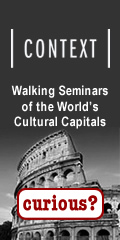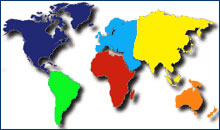'Tis the Seasons for the Tourists
High season, low season, tourist season, summer, winter...and just when is the best time to travel to avoid the crowds
Funny thing about tourist season is that it's actually not the time you want to be somewhere. Why? Well, because the darn place is full of tourists, of course! This is, admittedly, a bit of a self-defeating statement, and a wee bit elitist, but it's true.
Off-season travel is usually much more fun, as crowds are smaller, lines are shorter, and you can actually glimpse some locals in between the masses of camera-toting tourists flitting from their A/C bus into yet another cathedral or museum and back again.
The basics
High season and low season
Travel seasons always depend on the destination—not just the country or its geographic location or latitude, but the type of vacation destination it is.
For example, June is the heart of the summer high season in most of, say, Italy—except for in the ski resort towns of the Dolomites and the Alps, where it is the lowest fo low seasons. The villages are empty and most hotels and restaurants are shuttered. That, however, is an extreme example.
In most places, low season doesn't mean everything is buttoned up tight—it just means better bargains are to be had. Prices will be lower on hotels and airfares, and crowds will be blessedly much thinner on the ground.
- High season: Ski and beach destinations aside, summer (June 15 to Sept 21 or so) is high season in most temperate zones North America, Europe, Australia, South America)—through remember: summer in the southern hemisphere means roughly November to February.
- Low Season: Winter in these places is the low season (ski resorts excepted), with lower rates and fewer crowds (and, obviously, colder weather). Still, I love, say, Paris or Venice in February. The crisp air, the lack of fellow tourists, the sales in the stores. Ah, lovely.
- Shoulder seasons: There still kind of are "shoulder seasons" between low and high (in other words, spring and autumn), when crowds are thinner but still there, prices are not quite as high as summer, and the weather can be mild (but can also turn cold and rainy at the drop of a barometer), but it is not quite the sweet season it once was—thanks largely to big-mouthed travel writers like me crowing about how great everything is in shoulder season. It has become quite a popular time to travel—though airfares are still a bit lower (See the bottom of this page for more on shoulder season.)
- Beach destinations and the Carribean: Popular beach destinations mark the high season as whenever it is winter in the place where all their tourists come from—so when it is winter in North America it is high season for the Caribbean. Low season for the Caribbean is the June to November "Hurricane season"—but remember that there are islands well south of the typical hurricane belt, such as the Netherlands Antilles (Aruba, Bonaire, Curaçao) that still see a lull in visitors but where you don't have to worry too much about those massive storms.
- What about in the tropics? In semi-tropical and tropical destinations, you want the dry season (as opposed to the rainy season—or, in ever-positive brochure speak, the "green season"), which varies from place to place but always means: "Not just insanely hot, but also unbelievably humid!" There is a reason snowbirds flick back north from Florida in summer. Have you ever been there in August? And that's barely semi-tropical!
Focus on Europe
Summer in Europe
The most popular time to visit Europe is early summer, especially June and July. With the exception of ski resorts, this is the highest of high season, which means all of the services that cater to tourism throw open their doors and welcome in the droves. It also means that there will be droves.
Despite the opportunity to hit some of Europe's best festivals, I try to avoid travel at this time of year. The continent teems with what seems like more foreigners than natives, temperatures can soar, hotels are perennially booked, prices are highest (especially for hotels and airlines), lines at the popular museums and sights can stretch for blocks, and the wait can last for hours.
There is a caveat to this summer norm. Part or all of August is often considered part of the low season in many cities (except for Paris, where it's July). Europeans go on vacation at this time, which means the beaches are packed, but the cities are devoid of locals and crammed with tourists. Especially from August 15 to 31, most European cities either close down entirely (Rome is the most notorious) or go on severely shortened hours. And that feeling that there are more tourist than locals? For those last two weeks in August, it might actually be true.
The Joys of Wintertime
Of course, the dead of winter has its drawbacks, too. From mid or late November through Easter (except for Christmas week) is low season in most places. Although travel and hotel prices plummet and you can often have entire museums, churches, or even small towns to yourself, most local tourist industries take advantage of this calm period to freshen up.
Hotels and restaurants close shop for a week or month; museums are shut for reorganization; monuments and churches are shrouded for cleaning or restoration; and shops, tourist offices, and local transportation go on shortened winter hours. Some of the most touristed destinations, especially smaller cities, islands, spas, and places in the sun-drenched south, close up almost entirely.
From a touring point of view, Greece in February is a waste of time. Bigger cosmopolitan cities such as London, Paris, or Rome should pose no problem. In fact, they can be quite fun. Picture snowflakes falling gently through the oculus at the top of the Pantheon's dome in Rome, or ice skating on the plaza before Paris's City Hall by the Seine.
Keep in mind that it can get bitterly cold. You probably expect this weather in Scotland or Scandinavia, but winter does lash the entire continent. Although snow is probably not the first thing that comes to mind when you think of sunny Italy's Tuscany region, that's what I found there in spades one December (and found that tire chains to fit a rental are hard to come by in San Gimignano).
A Chip on my Shoulder about Shoulder Season
So what are you left with if you don't want to broil with the tourist crowds or shiver with the locals? The in-between time is called the shoulder season (er, two of them, actually), the precise parameters of which depend on what airline you're talking to. They usually include spring (Easter through mid June) and fall (late September to mid or late November).
Airlines offer reasonable rates, the majority of hotels, restaurants, and sights are open, and the weather tends to be pleasantly mild, if rather temperamental—prepare for rain, sudden heat waves, and/or cold spells. It might well be warm enough for a dip in the North Sea off of Ireland, but still cool enough for a ski run in the Alps.
For years, we traveler writers have been flippantly making such statements as "Savvy travelers often choose the shoulder season, when you'll find Europe neither too crowded nor a ghost town." Problem is, we never thought people would actually listen to us. These days, if you go in fall or, especially, the springtime, you'll find Europe teeming with folks who took our advice. (Darn them to heck!)
Well, At least these vacationers tend to skew more towards the independent traveler, guidebook in hand, rather than the tour-bus hordes of summer. Thing is, that, too, can be a bit of a drawback. See, the tour bus crowds are all putting up at chain hotels of four and five stars, and often eating either at their hotels or in large restaurants set up to cater to crowds.
This means that, while they make the lines for the Louvre and Uffizi stretch forever, and get in your way of taking a picture of the David, they won't gum up every aspect of your trip. Solo travelers, on the other hand, are, well, just like you, and you'll all be competing to book the same great little two- and three-star hotels, and reserve a table at the fantastic family-run bistro recommended in the guidebook. And, because of those guidebooks my colleagues and I have written, they tend to travel in shoulder season.
Er, sorry about that.
Related Articles |
Outside Resources |
This article was last updated in August 2007. All information was accurate at the time.
Copyright © 1998–2010 by Reid Bramblett. Author: Reid Bramblett.



 ShareThis
ShareThis

